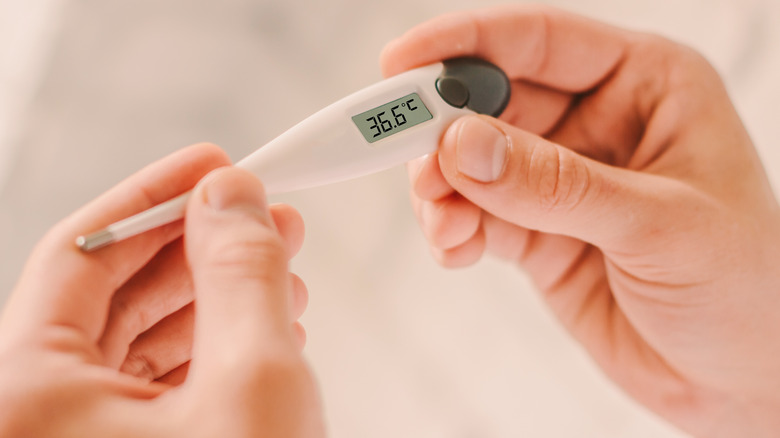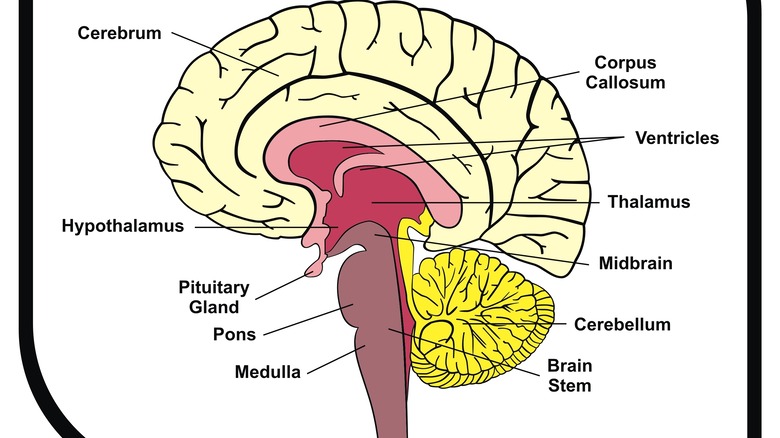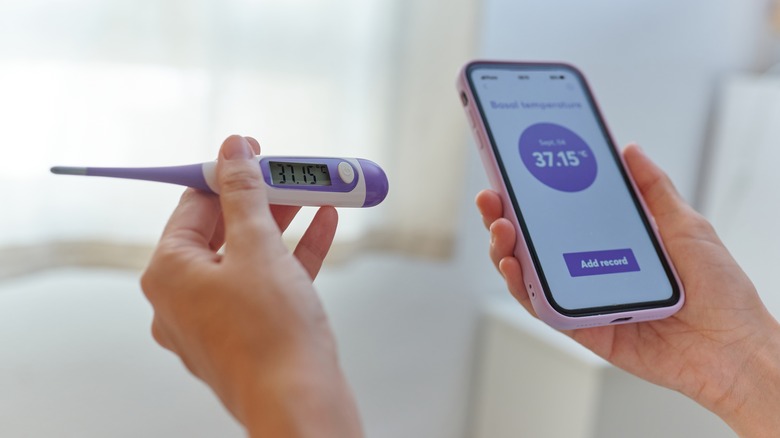Things You Didn't Know About Body Temperature
An old jokey myth about grade-school nurses is that all they ever do is take your temperature and send you back to class (via Brooklyn Eagle). However, like all things said in jest, there's a kernel of truth here. In fact, school nurses don't "only" take your temperature; rather, they "always" take your temperature. That's because body temperature is one of the most readily observable means for assessing human health, along with respiratory rate and heart rate. These measures are referred to as "vital signs," where "vital" is used to mean "life." In other words, vital signs are signs of life. Without breath, there can be no life. Without a heart beat, there can be no breath. But where does body temperature fit in?
According to a 2019 academic paper published in the Nature Public Health Emergency Collection, since the dawn of clinical medicine, body temperature has always been a diagnostic tool. Elevated temperature was seen as a sign of illness, for example. Cold flesh was a sign of death. Prior to the development of the thermometer at the turn of the 17th century, however, there was no way of measuring body temperature with precision, per The Conversation. And it wasn't until 1851 that scientists realized normal human body temperature hovered narrowly around 37 degrees Celsius (98.6 degrees Fahrenheit). Since then, body temperature, its measurement, regulation, and significance, has been delivering enormous insight into human health. Here are some of those insights, along with lots you never realized about body temperature.
Normal body temperature might surprise you
The notion that normal human body temperature is 98.6 degrees Fahrenheit dates back to 1851, according to the The New York Times. That's when German doctor, Carl R.A. Wunderlich, systematically measured the body temperatures of 25,000 patients and came up 37 degrees Celsius (i.e., 98.6 degrees Fahrenheit) as the average "normal" human body temperature. It quickly became the standard by which human body temperature was measured. However, even at the time, doubts were raised. Based on other studies conducted then, some believed the number was actually closer to 36.6 degrees Celsius (97.8 degrees Fahrenheit) or even lower.
Doubts persisted throughout the years. In 1992, a study published in JAMA suggested that there may have been some flaw in the early form of thermometer that Wunderlich used. By 2017, U.K. researchers had found that the average healthy body temperature among 25,000 British men was 97.9 degrees Fahrenheit, begging the question of whether there was, in fact, a flaw in Wunderlich's study, versus there being some phenomenon by which body temperature was getting lower in humans.
A 2020 study out of Stanford would seem to prove the latter. Analyzing 677,423 human body temperature measurements over the 157 years between 1862 and 2019, the scientists found a clear pattern of decreasing body temperature in humans over time. The pattern, which is continuing still, shows a decrease of around .03 degrees Celsius per decade, per Smithsonian Magazine, to which the study authors attribute to environmental factors.
Body temperature changes throughout your day and life
Although it's widely accepted that human body temperature has dropped since it was first set at 98.6 degrees Fahrenheit, the "official" number has not changed in the two years since the 2020 study out of Stanford made that abundantly clear. Perhaps that is because we have also learned, over time, that what is normal for body temperature is not so much a number as it is a range, according to the Mayo Clinic, which puts that range as being between 97 and 99 degrees Fahrenheit.
For example, the normal temperature for a newborn baby skews higher, according to Medical News Today, which estimates it as 99.5 degrees Fahrenheit, citing InformedHealth.org. The higher temperature reflects a faster metabolism, and a faster metabolism marginally raises body temperature. Conversely, the normal temperature range for older adults skews lower, according to Harvard Health — as low as 94 degrees Fahrenheit. Incidentally, the bodies of both babies and older adults are less efficient at regulating body temperature, according to Medical News Today and Cleveland Clinic. That may explain why both babies and older adults may seem less tolerant of temperature changes.
In addition, body temperature tends to increase with activity, and it's lowest in the morning when we first wake up for that very reason. Although body temperature veers to rise within its normal range over the course of the day and evening, it tends to decrease again as we get sleepy and decrease further still as we sleep (per WebMD).
Regulated by the hypothalamus
The body temperature of a healthy human is regulated by the hypothalamus gland, per InformedHealth.org. The hypothalamus gland is located deep inside the brain, adjacent to the pituitary gland, which, itself, is responsible for releasing hormones that control many important bodily functions, including temperature regulation, according to EndocrineWeb. The hypothalamus receives and interprets messages from the nervous system concerning key bodily functions, including regarding body temperature. In this sense, the hypothalamus may be viewed as the body's own internal thermometer, except that the process of temperature-taking is continuous throughout life.
In response to continuous temperature-taking, the hypothalamus then instructs the pituitary gland as to which hormones it should release in response, with the goal being "homeostasis." Homeostasis refers to life-sustaining equilibrium within the body. The hormones released, in response, by the pituitary gland, signal various bodily functions to take action. For example, when the message received by the hypothalamus is that the body's current temperature is rising — for whatever reason — it instructs to pituitary gland to release hormones that make the sweat glands produce sweat, which helps release heat and cool your body temperature (via Arizona State University's Ask A Biologist). When the message is that the body's temperature is falling, again, for any reason, the hypothalamus instructs the pituitary gland to release hormones that cause your muscles to shiver, which helps generate heat and raise the body temperature.
Fever and what it signifies
Elevated body temperature (in adults) does not become "fever" until 101.4+ degrees Fahrenheit, according to Denver Health. But fever itself is not a diagnosis. Rather, fever is a sign that something's "off," per Johns Hopkins Medicine. Nevertheless, fever from any cause will carry telltale symptoms such as flushing and a sensation of hotness and dryness of the skin, headache, body aches, nausea, and decreased rate of elimination. Conversely, one might also experience "the chills" as a fever sets in, or as it rises. These chills are the result of the body's involuntarily shivering, which the body will do in response to a threat perceived by the immune system. Shivering is the body's way of actually increasing body temperature. Although the body shivers when exposed to cold external temperatures, it also shivers for the purpose of attacking pathogens that are damaged by higher temperatures, according to Healthline, which says that this is the case with most infections.
In addition to infection, fever may be triggered by anything that disrupts the metabolism. For example, each of thyroid disease, diabetes, and atherosclerosis can affect body temperature. So too can some medications, including steroids and painkillers (via UpToDate). An allergic reaction may trigger fever. Some tumors may cause the release of hormones that tell the hypothalamus to increase body temperature (via Roswell Park Comprehensive Cancer Center). Since fever is an inflammatory response, it can also occur with acute trauma or tissue damage, including damage caused by heart attack (via Medical News Today).
Low-grade fever wants to be your friend with boundaries
An elevated body temperature isn't a quote-unquote "fever" until it reaches 100.4 degrees Fahrenheit. Even then, it's considered "low grade" (medical-speak for "mild") unless and until it reaches 102.2 degrees Fahrenheit, according to Emergency Hospitals. But a low-grade fever is a fever, nevertheless, and all of the uncomfortable symptoms associated with fever begin to occur at the law-grade stage. That being said, Dr. Kerry R. McGee makes an argument for not rushing to treat a low-grade fever — for example, with fever-reducing medication (via GoodRx).
"But treating a fever doesn't stop the infection that caused it — all it does is bring your temperature down," Dr. McGee writes. In fact, lowering the body temperature could slow your recovery, according to this 2021 study published in World Journal of Clinical Cases. Further, some antibiotics work better when the body temperature is elevated, according to a 2010 Study published in Antimicrobial Agents and Chemotherapy. Arguments in favor of treating a low-grade fever include the fact that fever can make you feel emotionally "down," along with the physical symptoms. In addition, even a low-grade fever can cause dehydration and loss of appetite.
In any case, low-grade fever that doesn't improve over several days should warrant a check-in with your doctor. So too should a persistent low-grade fever, which is one lasting two weeks or more, via Medical News Today. Either could be a symptom of an infection or condition requiring treatment. Here's why a high fever could lead to hallucinations.
The coldest body temperature a human has survived
The lowest body temperature that has ever been recorded in a person who survived is 56.7 degrees Fahrenheit. That is the temperature at which a Swedish medical student, Anna Bågenholm, was found when she was rescued after 80 minutes spent under the surface of an icy Norwegian stream following a ski accident in 1999, per Atlas Obscura. Although she was clinically dead with no discernable brain function at the time, Bågenholm was able to be resuscitated (and thawed, although that took nine hours). Bågenholm survived with only minor nerve damage. Doctors believe Bågenholm's brain survived her quote-unquote death because her hypothermic condition slowed down the chemical processes that lead to brain death — for long enough for her to be rescued and resuscitated via CPR, which was performed continuously before she was transported to a facility with a heart-lung machine (per Science Alert).
"While hypothermia is of course generally to be avoided, there are situations in which it can actually be useful," wrote Joe Schwarcz, PhD in a 2019 essay published by McGill University's Office for Science and Society. The essay regarded the Bågenholm case as anecdotal evidence that hypothermia could prove therapeutic in certain circumstances — such as cases of major blood loss following a gunshout wound. The idea Dr. Schwarcz puts forth is that inducing hypothermia could give surgeons time to treat the wounds before the blood loss leads to brain damage.
The hottest body temperature a human has survived
On July 28, 1980, Time magazine reported on a devastating heat wave that had already caused the deaths of more than 1,000 people in the 20 state-triangle formed by Texas, New York, and the Dakotas. "In Atlanta," the magazine wrote, "Willie Jones, 52, was discovered prostrate on the floor of his hot, airless apartment; half an hour after doctors packed him in ice, he was still unconscious, with an almost unheard-of body temperature of 116." This occurred on July 10, according to the Guinness Book of World Records, which later certified Jones' actual recorded body temperature of 115.7 degrees Fahrenheit as the highest body temperature that has ever been recorded for a person who went on to survive.
Heat stroke is diagnosed when the internal body temperature reaches 105 degrees Fahrenheit, according to certified registered nurse practitioner, Theresa Pluth Yeo, American Association of Critical-Care Nurses and writing for Clinical Issues. The risk of organ failure, and eventual death, rises precipitously as the body temperature goes above 106.7, according to WebMD. How Jones survived an internal body temperature nearly 10 degrees higher than the highest ambient temperature ever recorded in Atlanta, according to Extreme Weather Watch, is a mystery. On the other hand, the intentional raising of body temperature — known as hyperthermia has been used therapeutically for decades, if not millennia, in the treatment of cancer, according to a 2012 academic paper published by the Surgical Oncology Clinics of North America.
Body temperature and male fertility
In both men and women, a relationship exists between body temperature and fertility. For the moment, however, let's address the relationship between body temperature and male fertility. The ideal temperature for sperm production is actually significantly lower than the range of temperatures considered normal for the human body overall, via Healthline. Healthline puts that number at 93.2 degrees Fahrenheit, a full five degrees lower than the current normal average temperature of 98.6. The way the body regulates the temperature of the sperm-manufacturing and storage system is by keeping it largely insulated from the rest of the body via the scrotum, which is the sac that contains the testes.
Male fertility may be impaired by colder environmental temperatures. However, it is, and is more often, impaired by an elevated body temperature, according to the medical professionals at Fertility Associates of Memphis. Even a brief period of fever may render a man temporarily infertile, according to the authors of a 2016 study published in the journal of Oxidative Medicine and Cellular Longevity. Moreover, notwithstanding the body's well-honed mechanism of reducing body temperature in response to external stimulus, prolonged exposure to unnaturally-elevated environmental temperatures — such as the high temperatures that a professional baker might be exposed to in their workplace, can impair fertility, according to a 2018 study published in the Journal of Taibah University Medical Science, which demonstrated a higher rate of infertility among 137 male bakers versus 107 non-bakers.
Body temperature and female fertility
In women, the reproductive system's activities correlate with predictable body temperature changes, according to the Cleveland Clinic. Therefore, prior to menopause (the final menstrual cycle, via the Mayo Clinic), most women will experience predictable body temperature changes over the course of each monthly cycle. Each month, after a woman's ovaries release an egg, the hormone progesterone is released by her pituitary gland. Progesterone, among other things, tells the uterus to thicken its lining in preparation for pregnancy. For reasons still unknown to science, progesterone has a slight thermal effect on the body, according to the authors of a 2020 academic paper published in the journal, Temperature (Austin). This may cause a slight body temperature increase.
If the egg goes unfertilized, the pituitary gland, with the help of the hypothalamus (via InformedHealth.org), shifts its focus to producing the hormone estrogen, which initiates the shedding process of the uterine lining (i.e., menstruation and via Very Well Health) and the process of releasing another egg. Estrogen has the opposite effect of progesterone on body temperature, which is to say, that in the first half of a woman's menstrual cycle (prior to release of the egg), her body temperature may be marginally, but again, detectably, lower than it had been in the two weeks or so prior. Although these changes are slight, they tend to be detectable, enabling women with predictable cycles some room to "track" their fertility, according to the Cleveland Clinic.
Obesity and body temperature
Individuals with obesity seem to sweat more profusely than others, according to a 1968 study published in the journal of Human Biology. It might seem logical to deduce, from this, that people who are obese may run hotter than others, which may make them more prone to heat intolerance (of which profuse sweating is a symptom). However, a 2014 study published in the academic journal, Chronobiology International, found precisely the opposite, which is that "obesity is associated with a significant reduction of body core temperature," at least during the daytime, when body temperature is not normally at its highest level.
In fact, lower body temperature is associated with a slower metabolism, which is associated with higher BMI, according to board certified nutritionist, Dr. Joseph Debé. Nevertheless, a 2018 study published in the International Journal of Obesity found that among men and post-menopausal women, higher body temperatures were associated with the presence of obesity markers. Science has not yet come up with an explanation for the apparent discrepancy. However, Healthfully.com suggests that obesity may cause the body temperature to drop in the sense that obesity is associated with various conditions known to impair circulation (to wit: diabetes, high blood pressure, and atherosclerosis, among others). Any condition that restricts blood flow might lead to low body temperature.
Women may be the winner in the battle of the thermostat
It's an old cliché that holds that women tend to prefer warmer indoor temperatures, as compared with men. But this is one instance in which the cliché reflects things pretty much precisely as they are. Dr. Rob Danoff, who practices family medicine in Philadelphia, suggests that this phenomenon is owing to the fact that the average woman has a slower metabolic rate — and, therefore, lower body temperature — than the average man (via Doctors of Osteopathic Medicine). But the reason is not the focus at this time. Rather, thanks to the thought-provoking results of a 2019 study published in PLOS ONE, the focus is on the theoretical win that the 2019 study represents for all women in the workplace.
After testing 500 men and women on various math and verbal tasks in rooms of varying ambient temperatures and crunching the results, the study authors found that women tend to perform better on math and verbal tasks when the ambient temperature is set to higher. Men, by contrast, tend to perform better at lower temperatures. Further, the difference is far more pronounced among women than among men. Accordingly, the study authors conclude that, "gender mixed workplaces may be able to increase productivity by setting the thermostat higher than current standards." True, it's not a mandate. But for all the women out there shivering in their offices, it certainly seems a handy fact to have in your back pocket.












